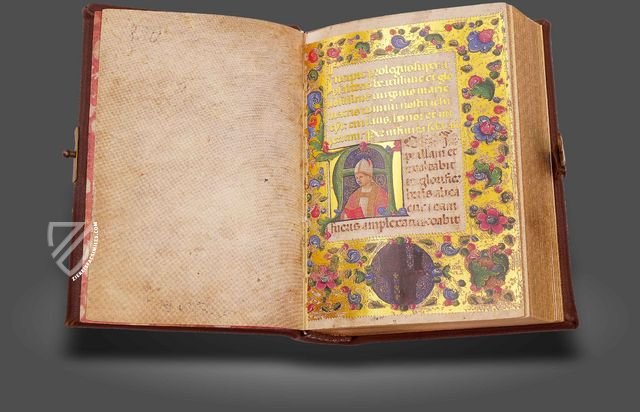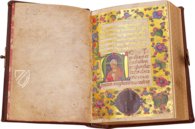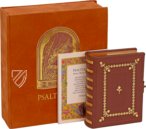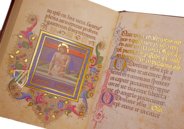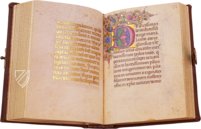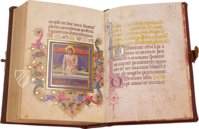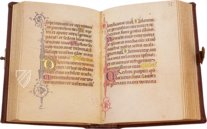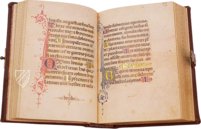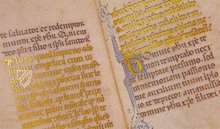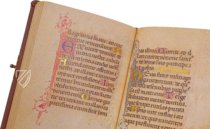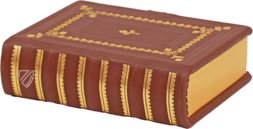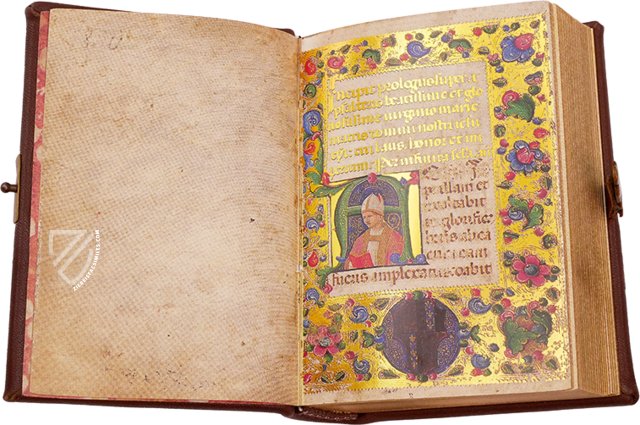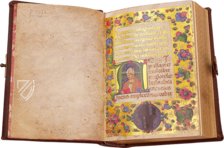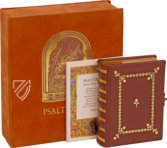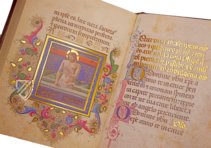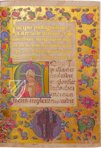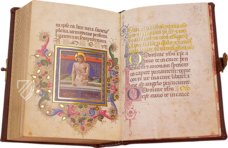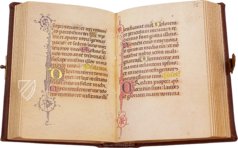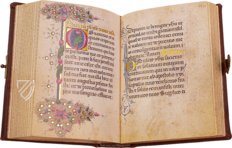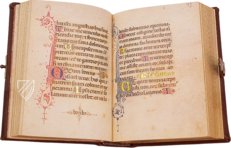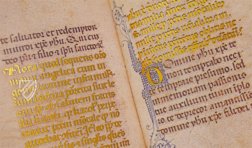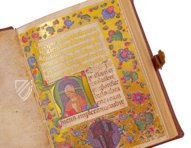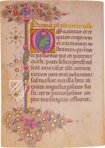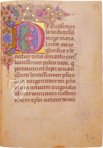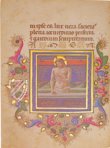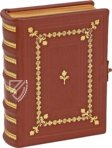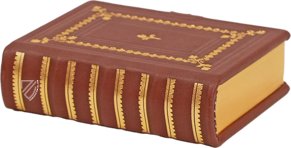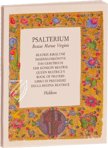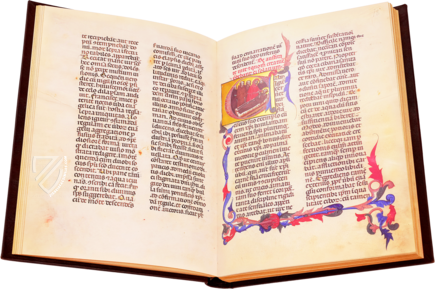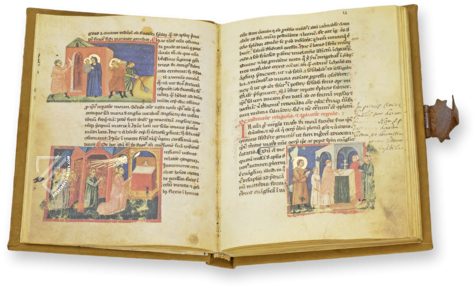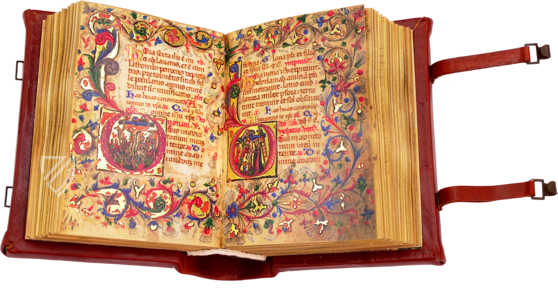Prayer Book of Queen Beatrice
(under 1,000€)
The Benedictine Abbey of Melk preserves a true gem of the Italian Early Renaissance, created in the second half of the 15th century in Upper Italy for Beatrice of Aragon (1457–1508), Queen of Hungary and Bohemia and daughter of the King of Naples. The prayer book of the influential patron of humanist Renaissance art and literature contains a compilation of Christian prayers addressed to the Virgin Mary, which were compiled by Bonaventure. The texts have not only been brought onto the small parchment pages of the codex in the highest calligraphic quality, but also shine completely in gold ink. The artistic chrysography is complemented by a magnificently designed incipit page, a large miniature of Christ, countless gorgeous decorated initials and gold-embellished borders, which make this manuscript a brilliant testimony to Beatrix's efforts to bring the new developments in art from her homeland to Hungary.
Prayer Book of Queen Beatrice
In the second half of the 15th century, a decidedly splendid little prayer book was made in Italy for Queen Beatrice of Aragon (1457–1508), which is not only an expression of her personal piety, but above all illustrates her activity as a patroness and lover of Italian Renaissance art and culture. Born in Capua, the daughter of the Italian King Ferdinand I of Naples (1424–1494) brought numerous humanist scholars and artists from Italy to Hungary after her marriage to the Hungarian King Matthias Corvinus (1443–1490) and had the first Renaissance palace outside Italy built in Visegrád. Through her influence as a patroness and also her political ambitions, Hungary quickly developed into a new center of the Renaissance in Eastern Europe. So it is hardly surprising that her private prayer book is also a literally shining gem of elaborate Upper Italian art.
Marian prayers in golden garments
Throughout the codex, the Latin prayers and psalms were written in the finest chrysography, meaning in gold script, on the small-format parchment pages. Although the gold ink of the Gothic rotunda has been somewhat eroded at some points over the centuries, the ancient splendor of this calligraphic masterpiece still captivates the viewer on every page. Golden and colored initials with sweeping red and blue fleuronnée ornaments that evolve into elaborate graphic borders complement the gold-glowing texts on almost every page. Compiled in the 13th century by the Italian scholastic and Franciscan Bonaventure, these are addressed throughout to the Virgin Mary.
Italian Renaissance art in the smallest of spaces
Measuring only 10.5 × 7.6 cm, the prayer book is introduced by a magnificent incipit page framed entirely by a lush, wide border of filigree golden vines and colorful leaves and flowers. The bas-de-page features the patroness's coat of arms on a blue background in a medallion incorporated into the border, and which is repeated in the large historiated initial in the text. After two more decorated initials with gorgeous gold-embellished borders follow on fol. 98r and 109v, a large miniature of the resurrected Christ in a sumptuous frame concludes the penultimate part. With a dramatically outstretched, bleeding hand, the naturalistically depicted "Son of God" invites the user of the manuscript to meditate on his fate and resurrection.
A Hungarian gem
Written by a later 17th century hand, a note below the last prayer indicates that the royal prayer book was later owned by Nicholas Pálffy of Erdőd (1512–1568) and Peter Koháry (1564–1619), two Hungarian military officers and noblemen. Today, the Renaissance gem is kept in the library of the Benedictine Abbey of Melk under the shelfmark 1845.
Codicology
- Alternative Titles
- Psalterium Beatae Mariae Virginis. Das Gebetbuch der Königin Beatrix
Das Gebetbuch der Königin Beatrix von Ungarn
Prayer Book of Queen Beatrice
Horae Beatae Mariae Virginis
Stundenbuch Beatrix von Ungarns - Size / Format
- 352 pages / 10.5 × 7.6 cm
- Origin
- Italy
- Date
- Second half of the 15th century
- Epochs
- Style
- Genre
- Language
- Script
- Gothic Rotunda
- Illustrations
- 1 large miniature, 1 historiated initial, 2 large ornamental initials and countless pen-flourish initials, ornate borders on 4 pages, chrysography
- Patron
- Beatrice of Naples, Queen of Hungary and of Bohemia
- Previous Owners
- Nikolaus Pálffy of Erdőd
Péter Koháry
Prayer Book of Queen Beatrice
Incipit Page
In the bas-de-page, the lower zone of the first page of the prayer book of Queen Beatrix of Hungary and Bohemia, the coat of arms of the royal patroness leaves no doubt about who commissioned it. Beatrix's coat of arms appears in a blue medallion with golden filigree in the Italian form of a horse-head shield. Due to abrasion and oxidation, some parts are difficult to decipher. The upper left and lower right quarters were once striped in bright red and gleaming gold. The other two quarters are each divided into three parts: narrow horizontal stripes in red and silver stand next to golden fleur-de-lis on a blue field, followed by golden crosses on silver.
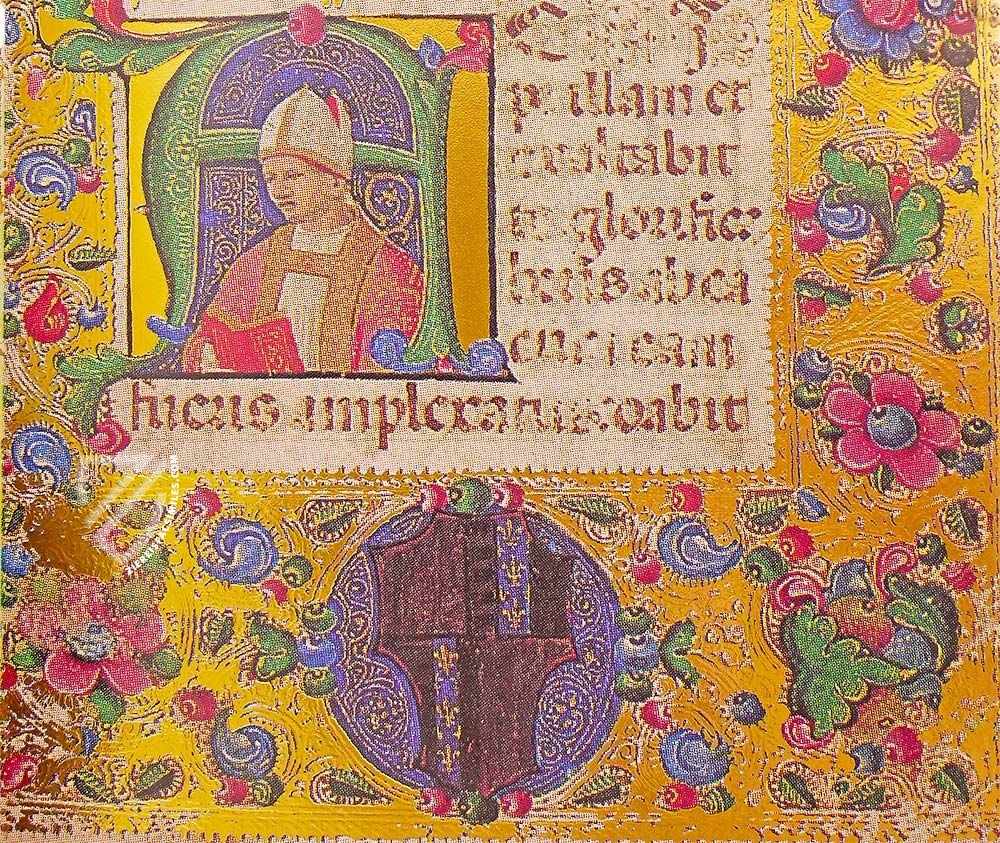
Prayer Book of Queen Beatrice
Man of Sorrows
The only miniature in this small royal prayer book is found after a thanksgiving prayer following the communion. Surrounded by the typical floral ornaments of the early Italian Renaissance and in a magnificent gold and blue frame, Christ appears here as the Man of Sorrows - an iconography that emphasizes the suffering of Christ and was intended to evoke the viewer's compassion.
The Risen Christ stands in his tomb, behind him the cross on which he died. While he grasps his bleeding side wound with his left hand, he presents the stigma on his right hand. At the same time, the nails that caused the pain are still stuck in the wood, recalling the previous suffering.
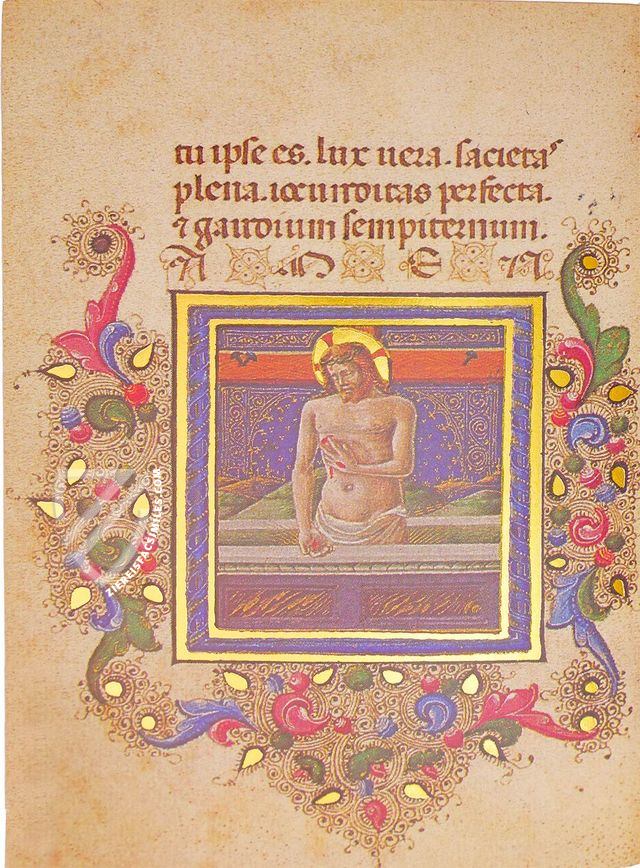
#1 Psalterium Beatae Mariae Virginis. Das Gebetbuch der Königin Beatrix
Language: English, German, Hungarian, Italian
(under 1,000€)
- Treatises / Secular Books
- Apocalypses / Beatus
- Astronomy / Astrology
- Bestiaries
- Bibles / Gospels
- Chronicles / History / Law
- Geography / Maps
- Saints' Lives
- Islam / Oriental
- Judaism / Hebrew
- Single Leaf Collections
- Leonardo da Vinci
- Literature / Poetry
- Liturgical Manuscripts
- Medicine / Botany / Alchemy
- Music
- Mythology / Prophecies
- Psalters
- Other Religious Books
- Games / Hunting
- Private Devotion Books
- Other Genres
- Afghanistan
- Armenia
- Austria
- Belgium
- Belize
- Bosnia and Herzegovina
- China
- Colombia
- Costa Rica
- Croatia
- Cyprus
- Czech Republic
- Denmark
- Egypt
- El Salvador
- Ethiopia
- France
- Germany
- Greece
- Guatemala
- Honduras
- Hungary
- India
- Iran
- Iraq
- Israel
- Italy
- Japan
- Jordan
- Kazakhstan
- Kyrgyzstan
- Lebanon
- Liechtenstein
- Luxembourg
- Mexico
- Morocco
- Netherlands
- Palestine
- Panama
- Peru
- Poland
- Portugal
- Romania
- Russia
- Serbia
- Spain
- Sri Lanka
- Sweden
- Switzerland
- Syria
- Tajikistan
- Turkey
- Turkmenistan
- Ukraine
- United Kingdom
- United States
- Uzbekistan
- Vatican City
- A. Oosthoek, van Holkema & Warendorf
- Aboca Museum
- Ajuntament de Valencia
- Akademie Verlag
- Akademische Druck- u. Verlagsanstalt (ADEVA)
- Aldo Ausilio Editore - Bottega d’Erasmo
- Alecto Historical Editions
- Alkuin Verlag
- Almqvist & Wiksell
- Amilcare Pizzi
- Andreas & Andreas Verlagsbuchhandlung
- Archa 90
- Archiv Verlag
- Archivi Edizioni
- Arnold Verlag
- ARS
- Ars Magna
- ArtCodex
- AyN Ediciones
- Azimuth Editions
- Badenia Verlag
- Bärenreiter-Verlag
- Belser Verlag
- Belser Verlag / WK Wertkontor
- Benziger Verlag
- Bernardinum Wydawnictwo
- BiblioGemma
- Biblioteca Apostolica Vaticana (Vaticanstadt, Vaticanstadt)
- Bibliotheca Palatina Faksimile Verlag
- Bibliotheca Rara
- Boydell & Brewer
- Bramante Edizioni
- Bredius Genootschap
- Brepols Publishers
- British Library
- C. Weckesser
- Caixa Catalunya
- Canesi
- CAPSA, Ars Scriptoria
- Caratzas Brothers, Publishers
- Carus Verlag
- Casamassima Libri
- Centrum Cartographie Verlag GmbH
- Chavane Verlag
- Christian Brandstätter Verlag
- Circulo Cientifico
- Club Bibliófilo Versol
- Club du Livre
- CM Editores
- Collegium Graphicum
- Collezione Apocrifa Da Vinci
- Comissão Nacional para as Comemorações dos Descobrimentos Portugueses
- Coron Verlag
- Corvina
- CTHS
- D. S. Brewer
- Damon
- De Agostini/UTET
- De Nederlandsche Boekhandel
- De Schutter
- Deuschle & Stemmle
- Deutscher Verlag für Kunstwissenschaft
- DIAMM
- Droz
- E. Schreiber Graphische Kunstanstalten
- Ediciones Boreal
- Ediciones Grial
- Ediclube
- Edições Inapa
- Edilan
- Editalia
- Edition Deuschle
- Edition Georg Popp
- Edition Leipzig
- Edition Libri Illustri
- Editiones Reales Sitios S. L.
- Éditions de l'Oiseau Lyre
- Editions Medicina Rara
- Editorial Casariego
- Editorial Mintzoa
- Editrice Antenore
- Editrice Velar
- Edizioni Edison
- Egeria, S.L.
- Eikon Editores
- Electa
- Emery Walker Limited
- Enciclopèdia Catalana
- Eos-Verlag
- Ephesus Publishing
- Ernst Battenberg
- Eugrammia Press
- Extraordinary Editions
- Fackelverlag
- Facsimila Art & Edition
- Facsimile Editions Ltd.
- Facsimilia Art & Edition Ebert KG
- Faksimile Verlag
- Feuermann Verlag
- Folger Shakespeare Library
- Franco Cosimo Panini Editore
- Friedrich Wittig Verlag
- Fundación Hullera Vasco-Leonesa
- G. Braziller
- Gabriele Mazzotta Editore
- Gebr. Mann Verlag
- Gesellschaft für graphische Industrie
- Getty Research Institute
- Giovanni Domenico de Rossi
- Giunti Editore
- Graffiti
- Grafica European Center of Fine Arts
- Guido Pressler
- Guillermo Blazquez
- Gustav Kiepenheuer
- H. N. Abrams
- Harrassowitz
- Harvard University Press
- Helikon
- Hendrickson Publishers
- Henning Oppermann
- Herder Verlag
- Hes & De Graaf Publishers
- Hoepli
- Holbein-Verlag
- Houghton Library
- Hugo Schmidt Verlag
- Idion Verlag
- Il Bulino, edizioni d'arte
- ILte
- Imago
- Insel Verlag
- Insel-Verlag Anton Kippenberger
- Instituto de Estudios Altoaragoneses
- Instituto Nacional de Antropología e Historia
- Istituto dell'Enciclopedia Italiana - Treccani
- Istituto Ellenico di Studi Bizantini e Postbizantini
- Istituto Geografico De Agostini
- Istituto Poligrafico e Zecca dello Stato
- Italarte Art Establishments
- Jan Thorbecke Verlag
- Johnson Reprint Corporation
- Josef Stocker
- Josef Stocker-Schmid
- Jugoslavija
- Karl W. Hiersemann
- Kasper Straube
- Kaydeda Ediciones
- Kindler Verlag / Coron Verlag
- Kodansha International Ltd.
- Konrad Kölbl Verlag
- Kurt Wolff Verlag
- La Liberia dello Stato
- La Linea Editrice
- La Meta Editore
- Lambert Schneider
- Landeskreditbank Baden-Württemberg
- Leo S. Olschki
- Les Incunables
- Liber Artis
- Library of Congress
- Libreria Musicale Italiana
- Lichtdruck
- Lito Immagine Editore
- Lumen Artis
- Lund Humphries
- M. Moleiro Editor
- Maison des Sciences de l'homme et de la société de Poitiers
- Manuscriptum
- Martinus Nijhoff
- Maruzen-Yushodo Co. Ltd.
- MASA
- Massada Publishers
- McGraw-Hill
- Metropolitan Museum of Art
- Militos
- Millennium Liber
- Müller & Schindler
- Nahar - Stavit
- Nahar and Steimatzky
- National Library of Wales
- Neri Pozza
- Nova Charta
- Oceanum Verlag
- Odeon
- Orbis Mediaevalis
- Orbis Pictus
- Österreichische Staatsdruckerei
- Oxford University Press
- Pageant Books
- Parzellers Buchverlag
- Patrimonio Ediciones
- Pattloch Verlag
- PIAF
- Pieper Verlag
- Plon-Nourrit et cie
- Poligrafiche Bolis
- Presses Universitaires de Strasbourg
- Prestel Verlag
- Princeton University Press
- Prisma Verlag
- Priuli & Verlucca, editori
- Pro Sport Verlag
- Propyläen Verlag
- Pytheas Books
- Quaternio Verlag Luzern
- Reales Sitios
- Recht-Verlag
- Reichert Verlag
- Reichsdruckerei
- Reprint Verlag
- Riehn & Reusch
- Roberto Vattori Editore
- Rosenkilde and Bagger
- Roxburghe Club
- Salerno Editrice
- Saltellus Press
- Sandoz
- Sarajevo Svjetlost
- Schöck ArtPrint Kft.
- Schulsinger Brothers
- Scolar Press
- Scrinium
- Scripta Maneant
- Scriptorium
- Shazar
- Siloé, arte y bibliofilia
- SISMEL - Edizioni del Galluzzo
- Sociedad Mexicana de Antropología
- Société des Bibliophiles & Iconophiles de Belgique
- Soncin Publishing
- Sorli Ediciones
- Stainer and Bell
- Studer
- Styria Verlag
- Sumptibus Pragopress
- Szegedi Tudomànyegyetem
- Taberna Libraria
- Tarshish Books
- Taschen
- Tempus Libri
- Testimonio Compañía Editorial
- Thames and Hudson
- The Clear Vue Publishing Partnership Limited
- The Facsimile Codex
- The Folio Society
- The Marquess of Normanby
- The Richard III and Yorkist History Trust
- Tip.Le.Co
- TouchArt
- TREC Publishing House
- TRI Publishing Co.
- Trident Editore
- Tuliba Collection
- Typis Regiae Officinae Polygraphicae
- Union Verlag Berlin
- Universidad de Granada
- University of California Press
- University of Chicago Press
- Urs Graf
- Vallecchi
- Van Wijnen
- VCH, Acta Humaniora
- VDI Verlag
- VEB Deutscher Verlag für Musik
- Verlag Anton Pustet / Andreas Verlag
- Verlag Bibliophile Drucke Josef Stocker
- Verlag der Münchner Drucke
- Verlag für Regionalgeschichte
- Verlag Styria
- Vicent Garcia Editores
- W. Turnowski Ltd.
- W. Turnowsky
- Waanders Printers
- Wiener Mechitharisten-Congregation (Wien, Österreich)
- Wissenschaftliche Buchgesellschaft
- Wissenschaftliche Verlagsgesellschaft
- Wydawnictwo Dolnoslaskie
- Xuntanza Editorial
- Zakład Narodowy
- Zollikofer AG

